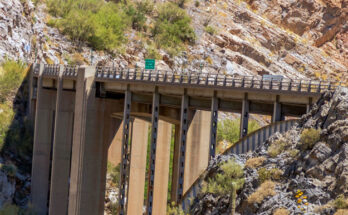Photo Courtesy ADOT: This message board is part of ADOT’s dust detection and warning system.
Innovative safety corridor helps drivers reduce speed during dust storms
Contributed Article/Courtesy ADOT
PHOENIX – Picacho Peak stands out as the signature landmark along Interstate 10 between Phoenix and Tucson. Next to the freeway, a transportation landmark entering its fifth monsoon season stands ready to activate when blowing dust dangerously reduces visibility.

During Monsoon Awareness Week, the Arizona Department of Transportation is reminding drivers how this first-of-its system works to enhance safety with signs that can lower the legal speed limit and message boards that post urgent updates. It stretches along 10 miles of I-10 between Eloy and Picacho, an area with a history of blowing dust and storm-related crashes.
The system has operated as designed since the start of the 2020 monsoon season and has activated during an estimated 50 blowing dust events. It’s achieving positive results too: Roadway sensors show motorists are slowing down in the dust detection zone when the system automatically reduces speed limits.
Thirteen visibility sensors mounted on posts along the freeway use light beams to determine the density of dust particles in the air. Once visibility drops to certain levels, the system activates overhead message boards and the variable speed limit signs.
As drivers approach the area, they are greeted by signs saying “Caution: Variable Speed Limit Corridor.” Then a series of programmable speed limit signs every 1,000 feet can change the legal speed limit from 75 mph to as low as 35 mph. More electronic signs are posted in the corridor to remind drivers of the temporary speed limit.
Drivers will also see overhead electronic message boards in and near the corridor that alert them to blowing dust and warn them to slow down. Speed feedback signs will inform drivers of their real-time speeds. An important reminder: The variable speed limits are enforceable, meaning drivers can get cited for exceeding the temporarily reduced speed limit.

This technology cannot replace common sense when it comes to driving in dust storms. While drivers will get almost instant warnings about hazardous driving conditions within the 10-mile corridor, the safest decision drivers can make is to delay travel if a severe storm is on the move. If caught in a dust storm, drivers should take the next exit if possible. When no exits are nearby, drivers should pull off the roadway, turn off lights, and take their foot off the brake.
For additional information on dust storms and safety, please visit PullAsideStayAlive.org.









